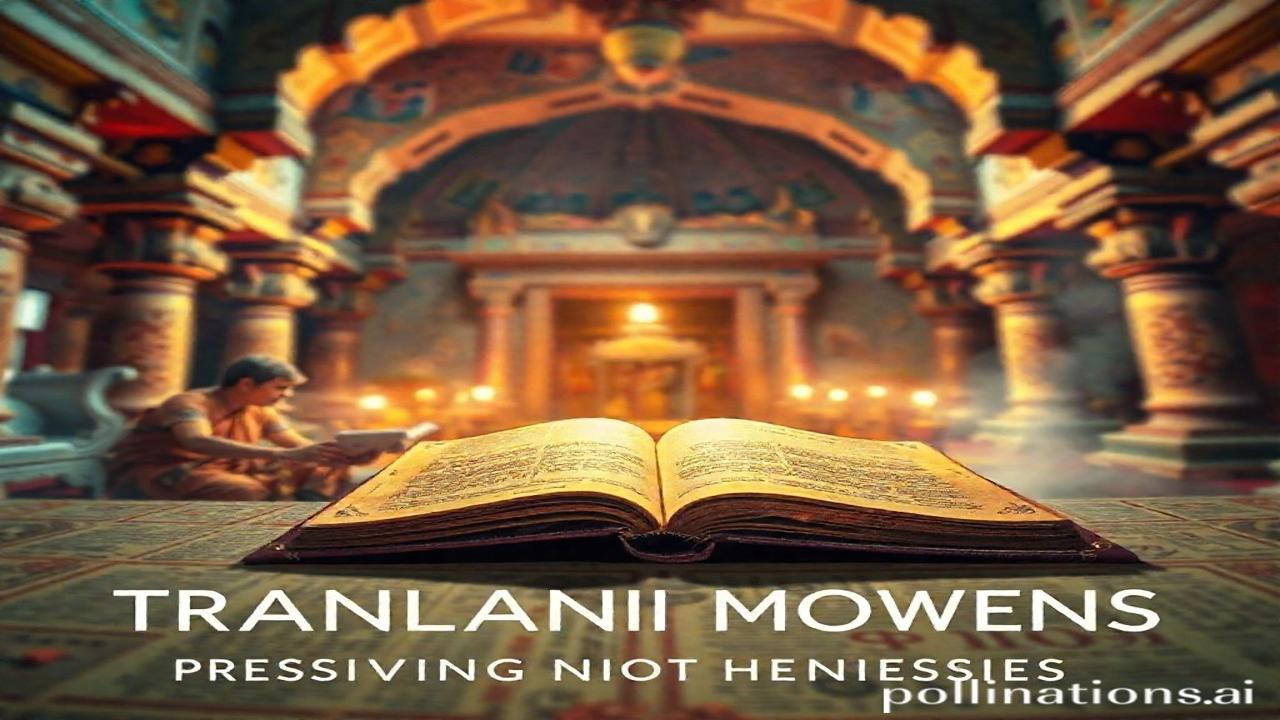Waqt Ke Panno Mein Chhupi Dhwani: Translation Movements and the Preservation of Ancient Texts
Kabhi kabhi lagta hai, agar hum aankhein band karke sunein, toh shayad humein uss zamane ki dhwani sunayi degi, jab haath se likhi kitabon ki khusboo hawa mein ghuli hoti thi. Imagine the soft scratch of a quill pen on parchment, the hushed whispers of scholars poring over ancient scripts… Those were the days when knowledge, meticulously copied and translated, was the lifeline connecting us to our glorious past. Aaj, hum unhi anuvaad (translation) aandolanon (movements) ki baat karenge, jinhone hamaari dhaohar (heritage) ko bachaya.
Itihasic Background: The Silent Guardians of Knowledge
Translation movements, in the context of preserving ancient texts, weren’t just about converting words from one language to another. They were conscious, often state-sponsored, efforts to safeguard wisdom. Think of it like this: ancient texts are like seeds, and translation movements are the fertile soil that allows them to blossom in new lands and new eras.
This wasn’t a single event; it was a series of movements across centuries and continents. In India, particularly during the Mughal era, Sanskrit and Prakrit texts were translated into Persian, opening up a vast treasure of knowledge to a wider audience. Earlier, Buddhist texts travelled along the Silk Road, being translated into Chinese, Tibetan, and other languages. Aur yaad hai Nalanda aur Takshashila universities? They were hubs of translation long before the printing press existed! These centers were not just about creating copies; they were about understanding, interpreting, and then disseminating the knowledge.
The why is simple: survival. Languages evolve, empires rise and fall, and the context in which these texts were originally written fades. Without translation, these precious insights would be lost, buried under the sands of time. Yeh ek intellectual rescue mission tha, agar aap sochein toh.
Zameeni Sach: The Story of Pandit Jagannath and Dara Shikoh
Imagine Pandit Jagannath, a renowned Sanskrit scholar, working tirelessly in the Mughal court of Dara Shikoh. He painstakingly translates Sanskrit texts like the Bhagavad Gita and the Yoga Vasistha into Persian. Dara Shikoh, himself a deeply spiritual and intellectually curious prince, saw in these texts a bridge between Hinduism and Islam.
“Panditji,” Dara Shikoh might have said, running his hand over the delicate script, “In shlokon mein, main ek aisi Shakti dekhta hoon jo insaan ko insaan se jodti hai. Yeh sirf alfaz nahi hai, Panditji, yeh hamari rooh ki awaaz hai.”
Pandit Jagannath, his eyes twinkling, would reply, “Shahzada, aapne bilkul sahi kaha. Yeh toh woh amrit hai, jo har zubaan mein sama sakta hai.”
These weren’t just dry academic exercises. They were collaborative ventures, dialogues between cultures, fueled by a genuine desire to understand and learn. Think about the meticulous copying of manuscripts, the long hours spent debating the nuances of meaning, the sheer dedication to preserving knowledge for future generations. Ma Rukmini ne aaj naye kapde pehne kyunki Pandit ji ko darbar mein sammanit kiya jane wala tha. These were the moments that made history, one painstakingly translated page at a time.
Dharohar aur Pehchan: Echoes of the Past in the Present
Today, we see the legacy of these translation movements in our libraries, universities, and even in our daily lives. The availability of ancient texts in multiple languages has allowed us to understand our past in a more nuanced way. The teachings of the Bhagavad Gita, the principles of Yoga, the wisdom of the Upanishads – all of these are accessible to a global audience, thanks to the efforts of countless translators throughout history.
Yeh Bharatiyata (Indianness) ka ek important hissa hai. It shows our capacity for intellectual curiosity, our willingness to engage with other cultures, and our commitment to preserving knowledge. We see it in the revival of Sanskrit studies, the efforts to translate regional literature, and the growing interest in ancient Indian philosophy. These are all echoes of those earlier translation movements, reminding us that our cultural identity is built on a foundation of intellectual exchange and preservation.
Mazedar Tathya: The Great Library of Alexandria and the House of Wisdom
Log samajhte hain ki translation movements sirf India mein hi hue the, lekin asli sach yeh hai ki aise aandolan duniya bhar mein hue the. Take the example of the Great Library of Alexandria in ancient Egypt. It was a hub of translation, collecting texts from all over the world and translating them into Greek. Similarly, the House of Wisdom in Baghdad during the Abbasid Caliphate was a major center for translating Greek and Persian texts into Arabic, which then preserved it for centuries to come. Yeh toh dikhata hai ki knowledge ki importance universal hai, aur har civilization ne ise bachane ki koshish ki hai.
Drishya aur Bhavnayein: Painting the Picture
Imagine walking into a dusty library, filled with the scent of old paper and ink. Sunlight streams through the windows, illuminating the rows of meticulously handwritten books. You can hear the faint scratching of a quill pen, the hushed whispers of scholars, the rustling of pages. The air is thick with the weight of history, the accumulated wisdom of generations. The temple walls feel cool to the touch, and the sound of chanting echoes in the distance. You are surrounded by the living legacy of those who dedicated their lives to preserving knowledge.
Antim Vichar: A Shloka to Ponder
“ज्ञानं परमं ध्येयम्” (Jnanam Paramam Dhyeyam) – Knowledge is the highest goal.
This shloka encapsulates the spirit of translation movements. They were not just about converting words; they were about pursuing knowledge, understanding different cultures, and preserving the wisdom of the past for the benefit of future generations. Let us continue to honor this legacy by embracing intellectual curiosity, engaging with diverse perspectives, and cherishing the power of translation to connect us to our shared human heritage.
